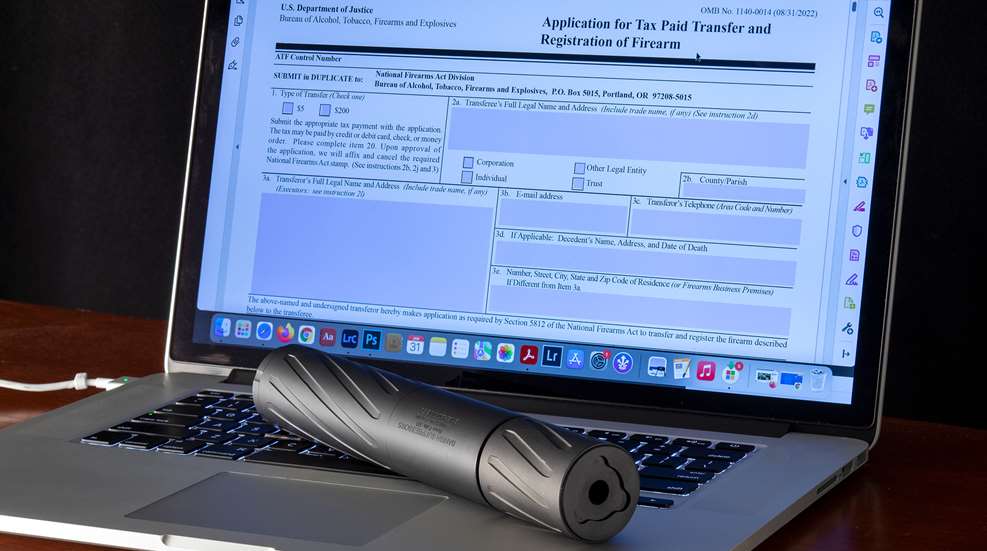
The nine-month to a year wait for ATF approval to legally possess a suppressor has been reduced in dramatic fashion—to 90 days, likely less—thanks to the Dec. 23 launch of a new electronically available Form 4. Some experts are confident the figure will be a few weeks as the anticipated digital rush clears. Despite the hearing-health benefits, suppressors were included in the National Firearms Act (NFA) of 1934. There they’ve stayed, along with fully automatic firearms, short-barreled long guns and destructive devices.
For a law-abiding citizen to take possession of a suppressor, they must complete Form 4 properly, submit fingerprints, have their background checked again and pay $200 for the tax stamp, among other hurdles. In 1990, when a total of 173,340 people submitted NFA forms (including Form 4s), response time was a couple weeks. By 2020, though, applications were up to 2,409,585—more than a 10-fold increase. The paperwork was still processed by hand, in a division not traditionally a budget-increase frontrunner, and delays increased to anywhere from nine months to a year.
How long will it take ATF to process the new electronically submitted Form 4s? “What used to be measured in months could soon be measured in days,” Brandon Maddox, CEO and founder of Silencer Central explained in an e-mail. “The ATF verbally communicated during the beta testing an objective of staffing approvals at 90 days or less moving forward. ... currently [what was] 10 months is looking like 60 days.”
The Federal Government’s mandatory migration to digital began in 2003, when the Paperwork Elimination Act took effect on Oct. 21. It required Federal agencies to provide the public with the option of using digital forms. Electronically processing and storing documents was a different challenge, though, and it wasn’t until 2008 when the ATF launched an eForm 4473 system that allowed FFLs to store gun-transfer documents digitally. It wasn’t a system for the average enthusiast to use, however.
That came a few years later, and more than 20 years after the IRS started accepting efile tax returns nationwide. ATF made Form 4s in eForm available to gun owners several times in the 2010s, but the sheer volume of submissions chronically crashed the system. The culprit was outdated code running the database, which rendered multiple attempts in 2014 and 2015 to scale up to demand fruitless. Then in 2016, rule changes took effect. No longer did an individual applying for a suppressor need the approval and signature of their area’s chief law enforcement officer. That meant software modification at a time when funding relief was nowhere in sight. Efforts to launch digital Form 4s took a backseat to other priorities that year.
Marvin Richardson was there during that frustrating period, serving as ATF assistant director, enforcement programs and services from 2014 to 2019. Of Richardson, Maddox said, “[he] is very open to feedback from the firearms industry…During his visit, we discussed the Hearing Protection Act, we discussed his goal of allowing licensees to store more data digitally to reduce ATF burden and help licensees.”
Electronic Form 4s were part of the conversation, but NFA stamp money goes in the federal general fund—not back to ATF—so there was no funding for a new system. Maddox offered to enlist outside help, but learned government agencies cannot accept industry funds in any capacity or form. That’s when he decided to contact his Senator.
Sen. John Thune (R-SD) responded by sending staff members to meet with ATF officials in Washington, DC, and the division that handles NFA paperwork in West Virginia. The reality of the latter’s budgetary constraints, in particular, was eye opening.
The fact-finding mission, along with industry efforts, led to a $10 million budget increase for the NFA division in 2018 to address the growing backlog. President Donald Trump signed a 2019 federal budget that boosted those funds by another $13.2 million.
The agency wasted no time. The system became operational on Dec. 23, 2021.
“Silencers will one day become deregulated because they are not a public safety risk,” Maddox predicts. “The more Americans that own silencers, the more education will permeate through American voters. The future looks bright for silencer owners and users.”






































